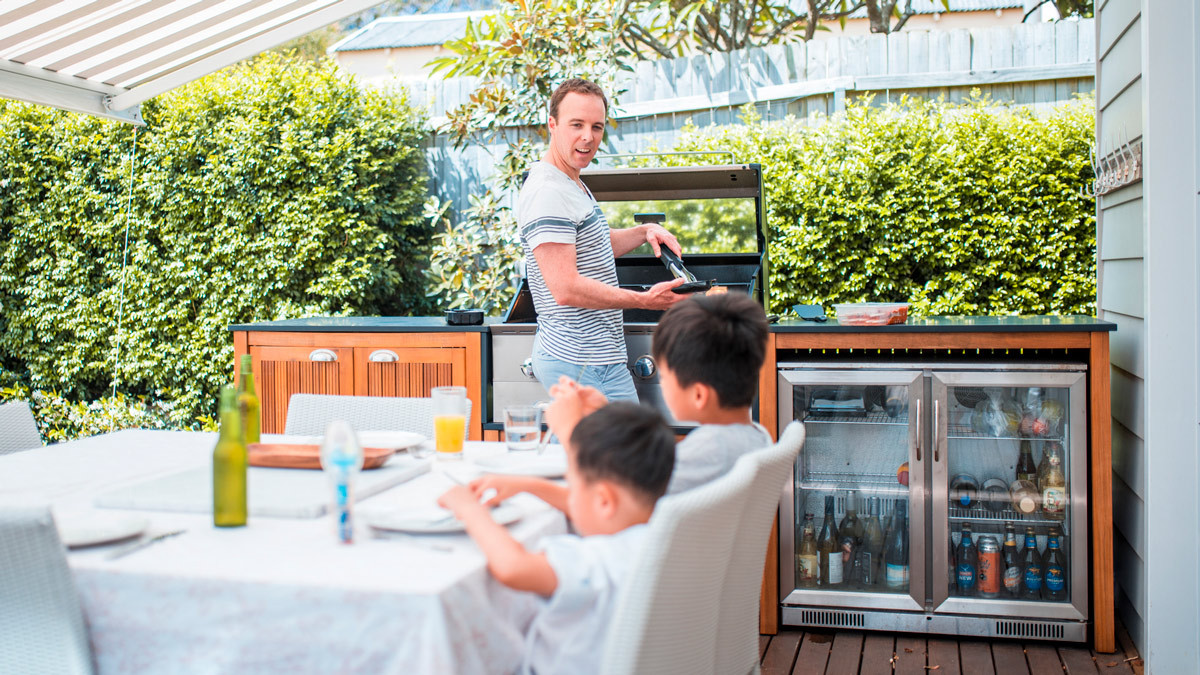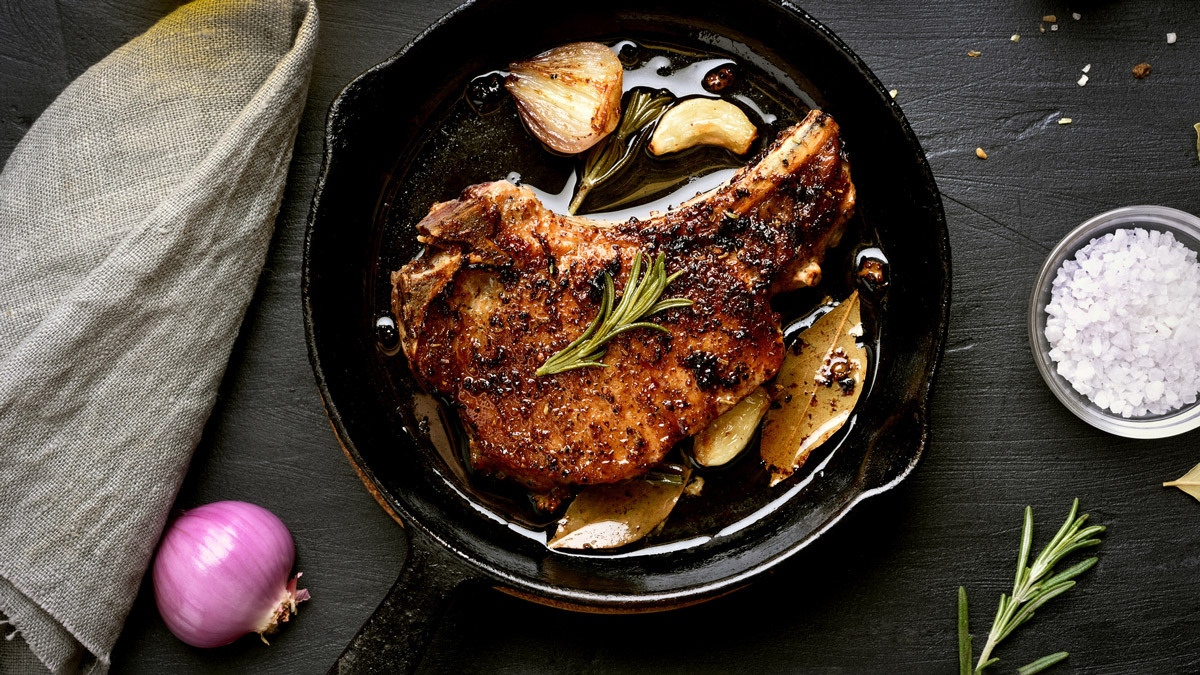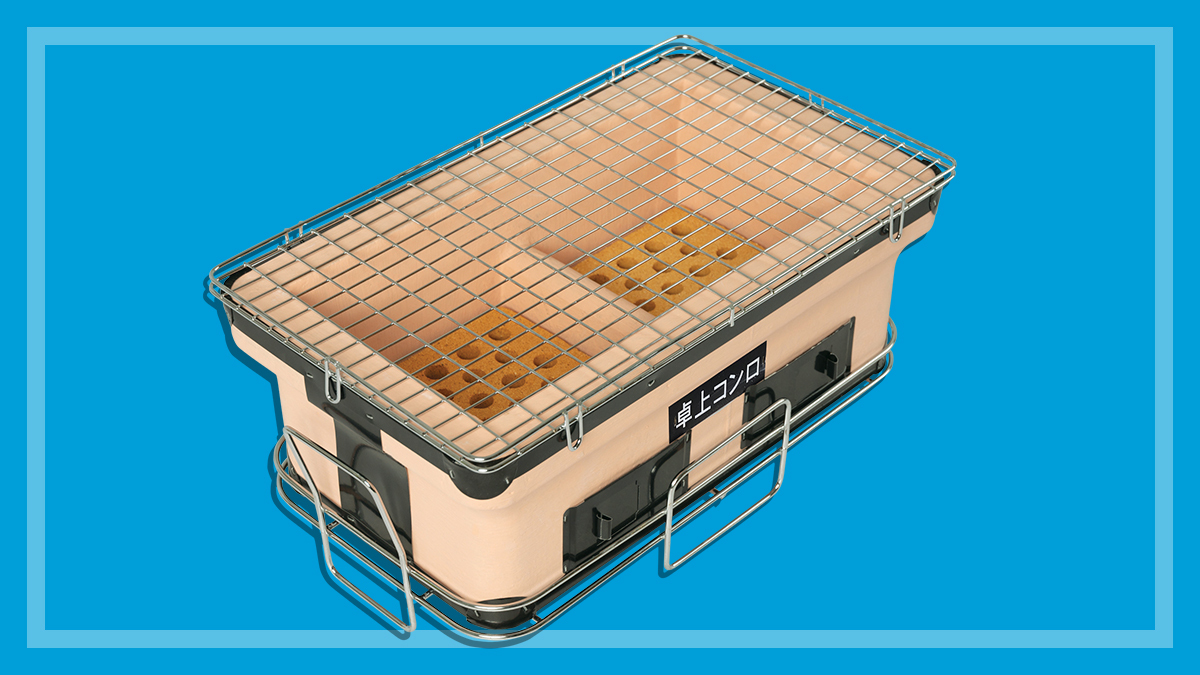Get our independent lab tests, expert reviews and honest advice.
How to choose the right beach shelter
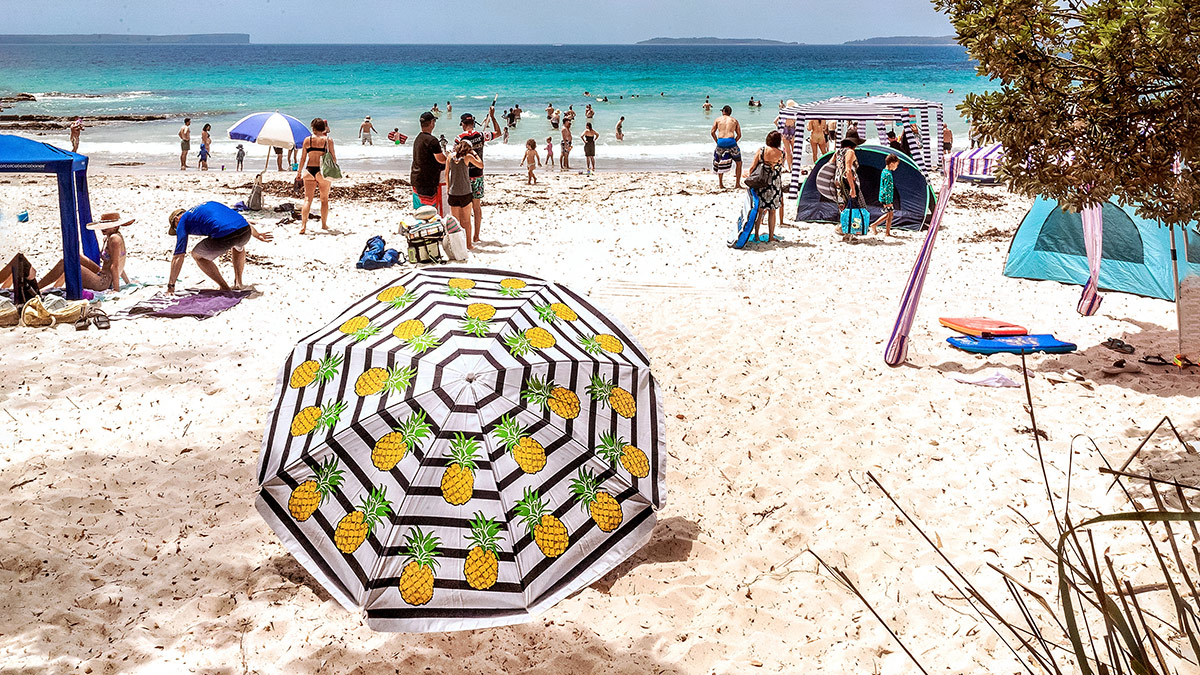
Despite decades of advice urging us to slip, slop, slap, seek and slide, too many Australians still think that a dab of sunscreen and maybe a hat is all they need if they’re heading out for a day at the beach.
Unfortunately, this simply isn’t the case, and our high rates of skin cancer are proof that we still aren’t getting the message about how harmful the sun can be.
On this page:
- How popular are beach shelters?
- What should I look for in a beach shelter?
- Types of beach shelters
- Beach umbrellas
- Beach tents
- Cabanas and gazebos
- Canopies and sails
- Beach etiquette: dos and don'ts
Sally Blane is the Chair of Cancer Council’s Skin Cancer Committee, and she says that we need to use all five forms of sun protection whenever the UV index outside is 3 or above.
“Sunscreen is essential, but it is just one part of sun protection,” she says.
“Start with covering as much skin as practical with clothing that blocks the UV, then combine with broad-spectrum, water-resistant, SPF50 or SPF50+ sunscreen, a broad-brimmed hat, shade, and sunglasses for the best protection. For the beach, rashies and longer swimsuits are best when swimming.”
Good quality shade is also essential, reducing UV exposure by up to 75%.
Sunscreen is essential but it is just one part of sun protection
Sally Blane, Chair of Cancer Council’s Skin Cancer Committee
“Having portable or temporary structures on the beach gives you somewhere to retreat from direct UV radiation. Umbrellas, large tents, marquees and beach shelters are good options to create shade when other shade structures like trees or built shade structures might not be available,” says Sally.
She adds that UV radiation can still reach you via reflection, particularly around water, which is why it should be used in combination with other shade protection measures.
“Shade structures should also never be used to extend your time in the sun. While not always possible, minimising exposure to UV radiation from the sun is the most effective strategy to prevent skin cancer,” she adds.
Different types of shelters and shade structures are a familiar sight on Aussie beaches, from umbrellas to tents and cabanas, and you can spend anywhere from $9 up to hundreds of dollars on products that promise to keep you protected from the sun.
Here we look at a few of the different types available and some things to consider before you buy.
How popular are beach shelters?
In a recent online survey, we asked the CHOICE audience about their use of sun shelters at the beach.
96% of respondents said they had used one when visiting the beach. Those who hadn’t said it was because they found them cumbersome or inconvenient to use , or didn’t visit the beach often or long enough to make it worthwhile.
Of those who had used a sun shelter, pop-up tents were most popular, with 77% of people using one. Umbrellas were next most popular (50%) followed by cabanas (35%). Non pop-up tents and canopies or sails were the least popular type of shelter.
Complaints about different kinds of shelters mainly related to their flimsiness, heaviness and their unsuitability for use when there’s any kind of wind. Several pop-up tent users described problems packing away their shelter at the end of the day.
What should I look for in a beach shelter?
Level of protection
Of course, the very first factor to consider is the level of sun protection it gives.
For portable shade, a good-quality product provides protection from direct UV from the sun, as well as scattered and indirect UV from reflective surfaces like water, sand and snow.
“This means that the fabric or materials used in the product have a UVE (Ultraviolet Effectiveness) rating of 95+% and [the structure and design] considers indirect UV radiation with an option for vertical screening,” says Sally.
Shown as a percentage, UVE applies to shade fabrics and measures the transmission of solar UVR (Ultra Violet Radiation) through the fabric. The closer the weave, the greater the protection. Materials with a high UVE rating offer better protection and a UVE rating of 95+ is the most effective.
Size
Start by working out how many people you intend to fit under your beach shade so you can look for the right size. If it’s a big group, you may need more than one structure, (eg, two or more umbrellas) or one very large one, like a cabana.
Weight and set-up
Weight can also be a deciding factor, plus ease of set-up. For instance, is it a one-person job or will you need extra help? The last thing you want is a sweaty struggle to put up or pack away a beach shelter while standing on scorching sand.
Also, be mindful of the quality of the fabric and the shelter’s overall durability – will it last? How sturdy will it be in those sea breezes? If you’re after something that offers privacy when you’re wriggling into or out of your swimmers, you want to be sure your shelter won’t blow away in a gust of wind.
Types of beach shelters
Not all shade-throwing devices are created equal and each type has its pros and cons.
“Any portable structure that provides shade is an important part of sun protection,” says Sally. “As a general rule, the more coverage provided by the product, the better the protection offered.”
The pros and cons of different beach shelters
Take the shade with you to the beach this summer with the perfect shelter for your family.
Pros: Cons: Pros: Cons: Pros: Cons: Pros: Cons:Beach umbrellas
Canopies and sails
Beach tents
Cabanas and gazebos
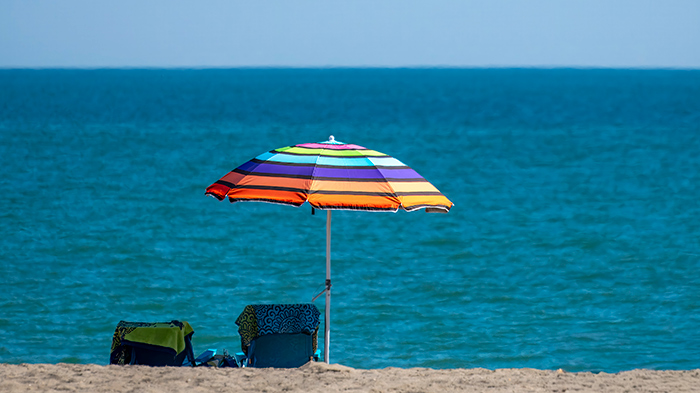
Beach umbrellas
What is it and what’s it made from?
These large umbrellas use shade fabric with a sun-protective coating and a long pole to stake in the sand.
As well as the traditional umbrella design, you’ll also find options that include built-in side panels that are designed to be used close to the ground.
They create more shade than the more familiar design and can appear quite similar to a small beach tent.
Price
Can start from as little as $9, but expect to pay upwards of $150 for some of the big-name brands. There are plenty of options between $50 and $100.
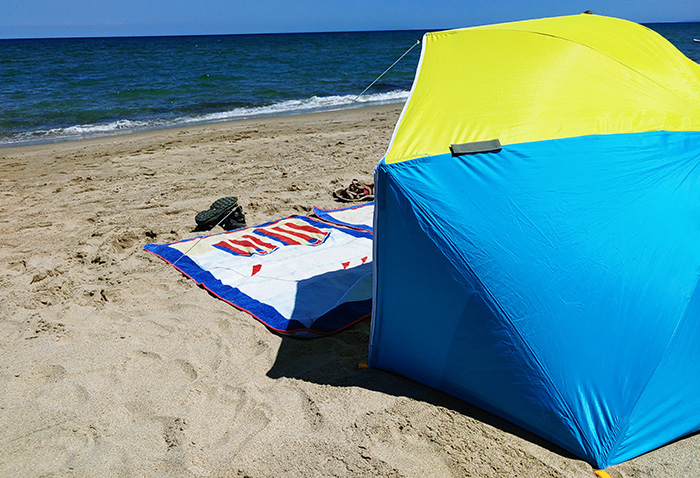
Pros
- Easy to put up and down, plus they come in a variety of colours and pretty prints.
- Lightweight, portable and don’t cause too much of a visual block for other beach users.
- Users told us they loved the portability and ease of use of beach umbrellas. They were praised for being easy to carry, providing better views of the beach and allowing adjustment so that you can change the angle as the sun moves to keep you shaded.
“Umbrellas are light, easy to carry and set up/take down. They are also adjustable when the sun moves,” one survey respondent told us.
Cons
- Complaints included their unsuitability in breezy conditions and the limited shade they provide.
- Others found them difficult to secure and expressed concerns about the risk they pose if they catch the wind and tumble down the beach.
- “Umbrellas require digging a hole in the sand with your hands that is deep enough to hold the umbrella – hard work! And they fall and blow over and only provide shade for a couple of people,” one noted.
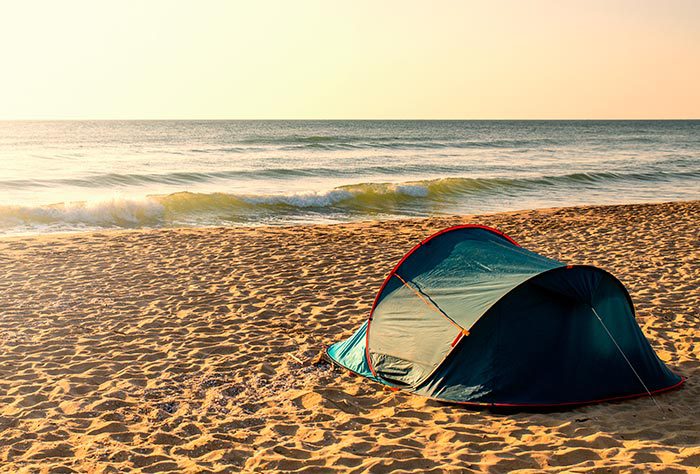
Beach tents
What is it and what’s it made from?
Usually lightweight polyester with a frame of some kind, designed for easy set-up. Pop-up models allow you to simply unclip, and the whole structure will spring into shape.
Guy ropes, sandbags or pegs create extra staying power. However, be warned: some users find it challenging to fold them down when they’ve finished using them.
This was the most popular type of shade structure in our survey: 77% had used a pop-up tent and 15% a non pop-up variety.
Beach tents that are not pop-up models will typically have a mechanism to pull the frame into shape. Sand pockets and pegs keep the shelter anchored, and may allow you to open the back or sides to boost ventilation.
Many of these types of shelters include a floor to help keep the sand away, and the larger models may allow you to stand inside, which can make them more convenient to use. You’ll find a range of sizes to suit one or two people or family groups of five or more.
Price
We found models starting at $25 all the way up to many hundreds of dollars.
Pros
- They are often quick to set up.
- Models that zip up can provide privacy if you need to change.
- Models that open on the sides are good for catching a cross breeze.
- “Mine is a cheap and cheerful Kmart one I’ve had for years. It’s easy to set up, and has three walls so it has more privacy. I love having a shady place to relax in,” one happy camper told us.
Cons
- Complaints include their tendency to get quite hot.
- Many told us that they were hard to put away, especially in windy conditions. “I am traumatised by pop-up shades that I can never get back into the correct shape and always end up breaking,” said one respondent.
- Versions that come with a floor may trap a lot of sand that has to be swept out later.
- Others complained that the structures are unsuitable for even a little bit of breeze and will collapse easily.
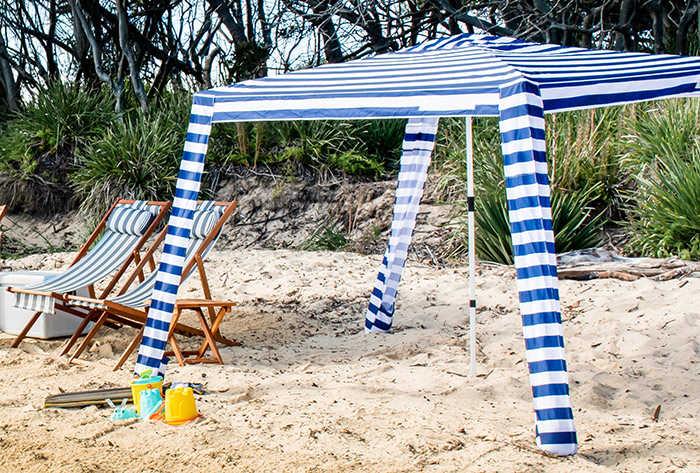
Cabanas and gazebos
What is it and what’s it made from?
Imagine that a tent and an umbrella had a love child – that’s essentially what a cabana is. It’s a square-shaped shelter with four legs (which have sandbags to secure it to the ground), a central pole to stake into the sand and a roof. Judging by the number of them on Aussie shores in the past few summers, they’re a beach trend that’s now well established.
Price
Prices start from less than $50 for a budget model all the way up to $500. There are plenty of options around the $200 mark.
Pros
- Great for families because they’re roomy and as they don’t have a sloping roof, there’s no need to slouch to fit under it.
- If set up properly in safe conditions, cabanas are sturdy, as they’re anchored in five spots.
- Manufacturers claim they’re simple to put up and down.
- With no walls, they’re well ventilated and don’t block out views entirely.
- “I like the cabana for its simple setup and the generous shade it provides. With its height and four open sides, getting in and out is effortless. It stays put in the wind far better than an umbrella and feels safer without the risk of a sharp pole flying away,” one cabana enthusiast told us.
- “My Cool Cabana is the best investment as a redhead who lives in Exmouth! It is easy to put up and does not fly away in the wind (unlike my beach umbrella). It also does not get stinking hot, unlike a pop-up shelter,” another told us.
Cons
- Not the cheapest option, so you’d need to be a committed beachgoer to get your money’s worth.
- No privacy for getting out of your salty swimmers.
- They take up a lot of room on the sand.
- You can’t tilt the top of the cabana to follow the sun, so the shade can end up outside the cabana instead of under it as the sun moves.
- The space they take up was a definite con for many. “Cabanas should be outlawed! Or only allowed far away from the shore. They are just too big and overtake the beach” one beach-goer complained.
- Models that come with guy-ropes create trip hazards and add to the amount of beach real estate you’re taking up, which may make you unpopular with others, particularly at busy beaches.
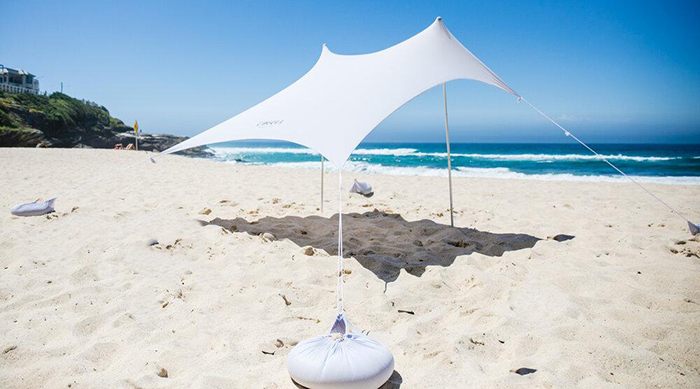
Canopies and sails
What is it and what’s it made from?
Canopies and sails consist of a coated fabric for UV protection, held up by aluminium poles and ropes. The result is an ‘open-air tent’ look.
Price
You can find them for under $60 but you might pay hundreds for some of the larger models.
Pros
- They can be very lightweight and easy to carry.
- Some styles can be set up in different ways, depending on what kind of shade you want.
- Once packed, a canopy doesn’t take up too much room, so you can keep it in the car ready to go.
- Fans of this style like the coverage they provide. “You don’t need to keep moving around to stay out of the sun,” one told us.
Cons
- It can take up a large area, so it’s not ideal on a crowded beach.
- Guy ropes used to hold up the canopy can also create a tripping hazard and you may need two people to hold the poles and ropes while setting up.
- You may need to adjust its tautness as the day goes on, depending on how windy it is.
- Because a canopy is entirely open, it won’t give you privacy either.
Beach etiquette: dos and don’ts
Whichever beach shelter you choose, try to be considerate towards other beachgoers when staking your claim to a patch of sand.
We surveyed our CHOICE audience to come up with a list of dos and don’ts for using shade structures at the beach.
Dos
- Try to avoid setting up directly in front of other people – stick to the back of the beach if possible.
- Secure your beach shelter properly so it’s safe.
- Be careful when packing your things away, as lots of sand can blow off and go in people’s eyes.
- Watch out for extra-long tent ropes being a trip hazard.
- Use a shelter that’s the right size for your group.
Don’ts
- Don’t set up too close to somebody else’s area – give groups already on the beach as much space as possible.
- Don’t block people’s view of the water – or their kids – with your shelter.
- Don’t be too noisy, either with your music or your conversation (and try to keep the chat PG-rated!).
- Don’t leave your rubbish behind – take your litter home with you or use the nearest bins. And always recycle whatever you can.

